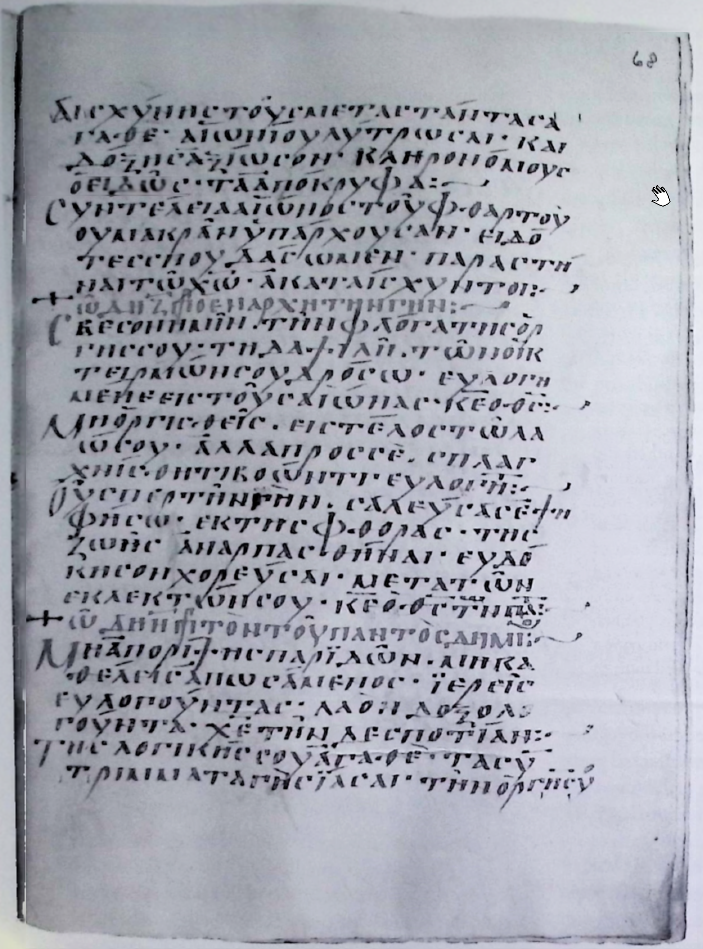Tropologion Sin.Gr. Mr 56+5
Background and Biography Background and Biography
Excerpts English from Nikiforova (2015)
With God, the Tropologion of all holy feasts of the whole year established by the saint [Church of] the Resurrection of Our Lord Jesus Christ [in Jerusalem].
- from Nikiforova (2015)
... 20. January 17. The commemoration of our venerable Father Antony, Ascetic and Hermit.
21. Another canon, for those who met their end in the earthquake while in good health.Greek from Nikiforova (2015)
Σύν Θ(ε) Τροπολόγιον πασών) τών άγίων έορτών πα(ν)τός τον έτους κατά τόν κανόνα τ(ής) άγίας Χ(ριστ)ού τον Ο(ε)ού ήμών Αναστάσεως5
- from Nikiforova (2015)
... Κ'. Μηνι. 'Ιανοναρίω ιζ'. Η μνήμη τον όσίου πατρός ήμών Αντωνίου τον άσκητού καί άναχωρητού.
ΚΑ'. Άλλος κανών εις τούς έν τώ σεισμώ τελειωθέντας εύεκτικός.Footnotes5 The same inscription has α pergament folio from α Greek tropologion, found in 1952 by beduins in Khirbet α1-Μird, at the ruins ο1 the monastery οf Kastellion in the Judaean desert, α 1ν kilometers ηοrth-east from the Μonastery οf St. Savvas. See: J. van Haelst, Cing textes provenant de Khirbet Μird, in: Ancient Society 22 (1991) 297-317, and Τ. Chronz, Das griechische Tropologion-Fragment aus dem Kastellion-Kloster und seine georgischen Parallelen, in: Oriens Christianus 92 (2008) 113-118.
Characterization by Lichtenberger and Raja (2025)From the ninth century AD there is a recently edited manuscript, a Hagiopolite Tropologion, which was used in the liturgy in Jerusalem (Sin. Gr. NE/MU 56+5) (Fig. 1.2).18 The text, of which only a Russian translation has so far been published, is remarkable because it is a liturgy read on 17 January in Jerusalem, commemorating the Christian victims of the earthquake of AD 749. In it we hear how the Christians of the region tried to cope with the dramatic catastrophe. The liturgy asks God to tame his wrath against the people and that the victims of the stroke (plege) may share in salvation.19 Some lines later, it explicitly mentions the victims of God shaking the earth.20 Also it is mentioned that death came suddenly (aprosdoketos).21 This new text is a remarkable testimony of coping with the earthquake and with the fact that it cost many innocent lives. It is remarkable that the text was especially read in the Levant, since the Georgian version of the Tropologion lacks the passage on the earthquake, underlining the regional impact of the seismic event.22
Footnotes18 cf. for the text and the genre: Nikiforova 2013; 2015; 2020; Chronz and Nikiforova 2014; Froyshov, Nikiforova, and Smelova 2023.
19 and 20 are illegible greek text in my copy
21 Τούς σωματικώς παταχθέντας καί συντριβέντας τή κολαστική ράβδω σου μή στερήσης έλέους έκ καθαίροντος, Χριστέ. αμαρτημάτων, σου προσχυνητάς καί δούλους, Κύριε. Τούς παραδωθέντας άπροσδοκήτω θανάτω καί άπρόγνωστον δλεθρον σωμάτων δεξαμένονς αΙωνίον, Χριστέ, σωτηρίας καί μακαριώτητος άξΙωσον (ed. Nikiforovaι 2020, 87).
22 Chronz and Nikiforova 2014.Greek Folio from Lichtenberger and Raja (2025)Chronology
Year Reference Corrections Notes January 17 January 17 none Seismic Effects
- for those who met their end in the earthquake while in good health
- "Also it is mentioned that death came suddenly (aprosdoketos)"
Locations
- Levant
Sources Sources
Online Versions and Further Reading References
